Blog
Spice, Herb and Veggie Beers
Fruit/Spice/Veggie/Herbal Beers
As homebrewers, we all know that one limit we have to what we can brew is going to be our imagination. While a majority of the BJCP categories have restrictions and direction as to how a style such as a pilsner or Baltic porter should be brewed and what it may include, the fruit, spice, herb and vegetable categories allow us a blank slate for our imaginations and ideas others believe to be pure insanity to truly run wild. My Mint Pale Ale is an example of taking a chance on an idea that a commercial brewer may not be willing to do, and watching that chance pay off.
History Lesson on Herbs and Spices in Beer
Now, the concept of adding these ingredients to beer isn’t anything new. Beer and alcohol, although not quite the way we know it today, has been brewed since the dawn of early civilization all over the world in a variety of ways. Holiday and seasonal beers use spices and herbs such as coriander, lemongrass, orange peel, chamomile, cinnamon, nutmeg, and star anise for creating different flavors and aromas; however it’s a far cry from how the ancients used spices and herbs, mainly for hallucinogenic and healing use in their alcohol. They believed fermentation and alcohol was a gift from the gods, and would use it either to try and communicate with them or heal themselves with their power. This was mainly in areas such as the Middle East, but more recently discovered in South America and our own Native American culture.
Fast forward to medieval Europe. Before the discovery and usage of hops, the main bittering additive to beer was a spice combination known as gruit. Basic gruit was made up of three mildly narcotic herbs: sweet gale aka bog myrtle, yarrow and wild rosemary, with each producer adding different herbs to their mix to produce distinct flavors and effects. Some used juniper (Urban Chestnut’s Old Tjikko is one modern beer that uses it, unfortunately not well if you’re not a fan of pine/resin flavor in your beer), while ginger and nutmeg are other examples still used today, but a majority of the herbs added had psychotropic properties supposed to stimulate the mind among other things. It wasn’t until hops started to gain use starting in the 14th century that saw their switch from gruit begin as well as the founding of drug control efforts by Protestant church groups and other trade organizations against merchants and the Catholic Church, effectively, but temporarily, eliminating the usage of herbal and spice additions to beer. Nowadays with the craft beer movement, those additions have become more commonplace as the population now goes crazy for pumpkin spice everything and lemongrass beers are getting notice, but psychedelic additions are still outlawed.
Ever-Changing Fruit Beers
Fruit and vegetable beers, however, have met with much less resistance and continue to gain in popularity, much to the chagrin of those who are anti-pumpkin. Randy Mosher states in his book Radical Brewing that fruit beers go back to Egyptian times, as they mentioned the use of dates and pomegranates, and even the Scottish tended to use gooseberries and elderberries in their beers. But the most common historical use of fruit in beers that are still made today are the fruit lambic styles like Kriek, Framboise and Peche. In these styles,traditionally the beer is transferred into an oak barrel on top of a specific fruit, then left open in a cellar. The wild yeast in the fruit and in the air causes the beer to spontaneously ferment, which gives those beers their sour and sweet tastes and smells from the lactic acids created during fermentation. The additional sugars in the fruit also add more sweetness to the beer rather than reducing it, with the added effect of boosting alcohol content. UK examples of fruit beer tend to be so heavily saturated with sugary fruit extracts or purees they’re hardly recognizable as beers. On the flipside, breweries here in the US such as New Glarus continue the Belgian tradition of sour fruit beers, albeit using cultured wild yeast strains for better control of fermentation and flavor. Two examples of local St. Louis brewed beers that use fruit or fruit juices primarily for flavor and not so much fermentation are Schlafly in their raspberry hefeweizen, in which raspberry puree is used in the secondary; the other is Urban Chestnut with their Berliner Weisse, where they use the traditional Berlin method of adding raspberry syrup at the pour.
Now Drink Your Veggies
Moving on to the vegetable beers, while any beer can be brewed with vegetables (Brooklyn Brew Shop for example has a recipe for making a gluten-free carrot pilsner), the most common vegetable beer on the market is one with a love/hate relationship, the pumpkin beer. While history books state the pilgrims were looking for the New World to set up shop and start new lives, one fact they tend to skip over is that they were primarily looking for land so they could gather ingredients and start brewing, as their beer supplies on the ships were running out as water was difficult to store and keep sanitary over a period of time. Beer was a much more stable and more importantly bacteria/disease free thirst quencher that could be kept sanitary for longer periods of time. However once they reached the New World, much of what they needed for brewing wasn’t available, and they tried a variety of natural resources before settling on pumpkins, which contrary to some beliefs are rich in starches and sugars necessary for mashing, fermenting and flavoring as are other members of the squash family. In the past, the pumpkins were pressed and pulverized, then the juices were collected then boiled, hopped,
cooled and fermented, becoming malt beer. Nowadays there are numerous ways to prepare pumpkin for brewing use. Some homebrewers cut it up or bake it before turning it into a pulp and adding to the mash for scarification while others still use the pressing method to get the fermentable juices out. Commercial breweries tend to use pumpkin puree only due to ease of use, while others use the pie spices only as it’s cheaper and the general public is usually unaware or doesn’t care as long as they can get their fall fix of pumpkin or pumpkin spice.
BJCP Guideline For These Styles
BJCP 2015 guidelines for each beer leave room for experimentation and creativity, however the main requirements are that for competition beers the spice, herb, vegetable or fruit needs to be specified in the entry and should be the predominant flavor and aroma, but balance is needed between what is used and the malt, hops and yeast. Appearance and mouthfeel should be focused on the beer’s base style, so in other words a pumpkin stout should look and feel like a stout in terms of color, body and head retention. With the fruit beers however, if using a lighter color beer like a wheat or a blonde ale some of the fruit color should be noticeable as a slight to moderate tint. The base style also needs to be specified in BJCP sanctioned competitions, however Autumn, Christmas or winter spiced beers as well as fruit lambics or fruit based Belgian specialty beers should be entered under those respective categories according to the new 2015 guidelines. Any beers using peppers should be entered in the SHV category, however in the case of a combo fruit/vegetable/pepper beer, it should be entered in the new 29B Fruit and Spice category.
That’s all I have for now, new post coming soon. Until next time, happy brewing and God Bless
Homebrewing, Beer News and Product/Brewery Reviews
Where Beer Began
Beer, believe it or not, has been around since the dawn of civilization. The rough estimate is alcohol, even though nobody knew what it was at the time, was discovered by accident over 10,000 years ago in the Middle East. How it was discovered is still a mystery. Well, I take that back, scientists and historians have a general idea how alcohol came to be, they just aren’t sure how us humans figured it out.
Ancient Alcohol
Now, if you’ve ever watched the Bob Ross show, Joy of Painting, you’ll remember his term “happy accidents”. That’s essentially what alcohol was. The theory on how alcohol, and later officially beer, was discovered is sugars from honey or accidentally malted grains got into water, combined, and the resulting mixture was spontaneously fermented by wild airborne yeast or bacteria. Belgian lambic beers are a perfect example of spontaneous fermentation, I highly recommend trying one, especially if you aren’t big on hop flavor or aroma in beer. And not too surprisingly, beer became the cornerstone of civilization. Mesopotamians used it as currency, writing was supposedly developed as a way to keep track of grains and brewing methods, and beer was sanitary to drink. Ancient Egyptians used it for real medicinal purposes, especially for stomach problems. A good source on brewing history is Sacred Herbal and Healing Beers, which gives the history of brewing worldwide as well as ancient/historical recipes. Some of those recipes and purposes behind them I’ll be exploring in this blog at a later date.
Beer Beginnings For Me
Like many of us, I “discovered” beer and alcohol in high school (DISCLAIMER, I do not condone underage drinking), but didn’t discover good beer and alcohol until college, and only learned how to start making it a few years ago from a one-gallon recipe kit from Brooklyn Brew Shop. I’m still learning more every day when I create my own recipes, talk with local brewers, visit , or find articles online. To this date I’ve brewed dozens of ales, had some success with meads, and still doing some work on figuring out lagers and ciders. I’m even exploring a potential shortcut on making rice wine. Some of these ideas have been hits, others, well, you can’t win all the time. I’ll be posting more on each of these as time goes on. I’m keeping this short as I’m planning on making a post tomorrow of the process I’ll be using to make a brown ale I call Drunken Otter, and how I came up with the name and idea of it. Until then, good night, and God Bless.
Drunken Otter American Brown Ale
The story behind Drunken Otter American Brown Ale
It wasn’t until roughly 18 months ago when I felt confident enough to start making my own beer recipes. Due to space, equipment and knowledge constraints, it wasn’t until this year when I switched over to all grain brewing and started using the brew in a bag method on my stovetop.I purchased a nylon mesh straining bag from my local homebrew supply store with an idea in mind. I’m a fan of brown ales, and one type of English barley malt that’s popular in them is Maris Otter. A nickname that my family stuck me with a long time ago was “Otter” (long story, trust me), so I decided to make a brew incorporating the two. Otter Beer didn’t sound as appealing, or as funny. Then I remembered one of my good buddies affectionately calls me “drunken b*st*rd”. I combined the two, and Drunken Otter was born.
Take out the guesswork, use brewing software like Beersmith
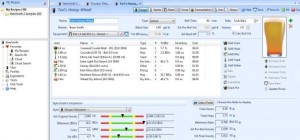 Granted you will need to occasionally do brewing calculations by hand and calculator. I think it’s best everyone who does brewing should know how in case the zombie apocalypse occurs and they live long enough to make some beer. I digress though, and I’m sure you can tell I’m joking about the zombie apocalypse. But there is computer software out there that allows you to take a decent amount of the guesswork out of brewing. You can find a list of available brewing software at Homebrewtalk, an online forum I joined when I first started out. Myself, I use
Granted you will need to occasionally do brewing calculations by hand and calculator. I think it’s best everyone who does brewing should know how in case the zombie apocalypse occurs and they live long enough to make some beer. I digress though, and I’m sure you can tell I’m joking about the zombie apocalypse. But there is computer software out there that allows you to take a decent amount of the guesswork out of brewing. You can find a list of available brewing software at Homebrewtalk, an online forum I joined when I first started out. Myself, I use Beersmith. Beersmith allows you to fine tune your recipe when it comes to alcohol percentage, color, bitterness from hops, track fermentation, you can keep it simple or get really technical. It comes with pre-loaded recipes, or you can create your own based on an established style. Below is a screenshot of a pre-loaded recipe in design mode so you can get a rough idea of how it looks
Creating a beer recipe
Now, when creating a beer recipe, if you’re going with an established style you want to use the right grains, yeast and hops. Brown ales are, well, brown, so aside from the base malt which gives the grains the enzymes needed to create the basic sugars the yeast needs to chow down, you need specialty and adjunct grains to help give flavor and aroma. Specialty and adjunct grains are treated differently than base grains in that they are malted differently and are either kiln or drum roasted to certain points to modify the sugars in the barley. I used brown malt, chocolate malt, and caramel malt in addition to the Maris Otter base malt to give the brown ale its trademark color and sweet, bready smells and flavors. These malted barley grains are then crushed by a grain mill beforehand to crack their husks and expose their insides so the enzymes and sugars can be released during mashing.
What goes into the brewing process: Mashing
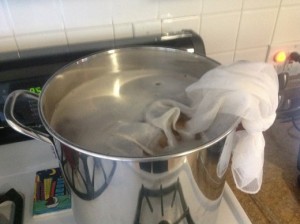 With the brew in a bag method, you’ll need at least a 5 gallon pot, preferably stainless steel. You’ll need a gallon of water for every two pounds of crushed malt you use. Since I do three gallon batches, I’ll need six pounds of grain. Put the grains into the mesh bag, make sure to keep it loose, then tie up the open end. Heat your water to 160 degrees F, then gently place the bag in the pot. Check the temperature with a thermometer, it should drop to around 150 degrees F. Hold the water around this temperature for 60-75 minutes, depending on the recipe style. Some beers require longer mashing times than others. Work the bag around with a large stirring spoon so the grains are able to move inside and release the enzymes needed for boiling and fermenting. Once time is up, lift the bag out of the sugar water mix in the pot, now called wort, and let any liquid left in the bag drain out. This may take a few minutes. I’d urge against squeezing the bag, as this will release tannins and other particles you don’t want into the wort and damage the flavor of the beer.
With the brew in a bag method, you’ll need at least a 5 gallon pot, preferably stainless steel. You’ll need a gallon of water for every two pounds of crushed malt you use. Since I do three gallon batches, I’ll need six pounds of grain. Put the grains into the mesh bag, make sure to keep it loose, then tie up the open end. Heat your water to 160 degrees F, then gently place the bag in the pot. Check the temperature with a thermometer, it should drop to around 150 degrees F. Hold the water around this temperature for 60-75 minutes, depending on the recipe style. Some beers require longer mashing times than others. Work the bag around with a large stirring spoon so the grains are able to move inside and release the enzymes needed for boiling and fermenting. Once time is up, lift the bag out of the sugar water mix in the pot, now called wort, and let any liquid left in the bag drain out. This may take a few minutes. I’d urge against squeezing the bag, as this will release tannins and other particles you don’t want into the wort and damage the flavor of the beer.
Boiling process and adding hops
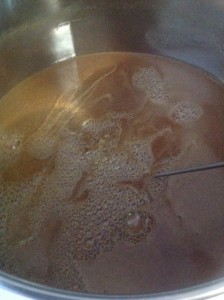 Once the grain bag is removed, it’s time to bring the liquid to a boil. Set your burner on the highest setting until a foam begins to form and then breaks, showing signs of boiling. This is the time you begin adding your hops. Even though Drunken Otter is an American Brown Ale, I decided to change a few things based on results I got back from a competition and used East Kent Goldings hops for bittering the beer and Fuggle hops for flavors and aromas. Both hops are originally native to England, where brown ales originated. However I went with the US version of Fuggles, partially because the aroma profile is slightly different, but I’ll admit being lazy and not asking my homebrew supply store if they had the UK version.
Once the grain bag is removed, it’s time to bring the liquid to a boil. Set your burner on the highest setting until a foam begins to form and then breaks, showing signs of boiling. This is the time you begin adding your hops. Even though Drunken Otter is an American Brown Ale, I decided to change a few things based on results I got back from a competition and used East Kent Goldings hops for bittering the beer and Fuggle hops for flavors and aromas. Both hops are originally native to England, where brown ales originated. However I went with the US version of Fuggles, partially because the aroma profile is slightly different, but I’ll admit being lazy and not asking my homebrew supply store if they had the UK version.
Hops. I’ll keep it simple for now.
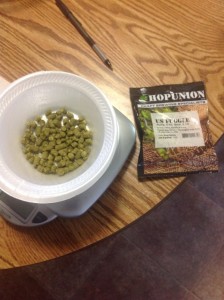 A little history lesson. Hops haven’t always been used in beer. Looking back through the history of it, hops have only been used for roughly 1300 years. Not exactly new, but they’ve stuck around. Before then, people just used a variety of herbs and roots to bitter and flavor the beer. Beer, when brewed, is sugar water in a sense, and something is needed to balance out the sweetness and give some preservative acids to allow it to last longer. While there are hundreds of varieties of hops worldwide, they are used only for three functions in beer: bittering, flavor, and aroma. Hops for bittering are added at the start of the boil, and any flavors or aromas they contribute get cooked off, but their acids remain. Hops with higher acids are usually used here for beers like IPAs where a lot of hop bite is wanted. Flavoring and aroma hops are added within the last 15 minutes of the boil. These hops don’t offer much in terms of bittering acids, but give citrusy, spicy, pine, or earthy aromas and flavors found in pale ales or lagers.
A little history lesson. Hops haven’t always been used in beer. Looking back through the history of it, hops have only been used for roughly 1300 years. Not exactly new, but they’ve stuck around. Before then, people just used a variety of herbs and roots to bitter and flavor the beer. Beer, when brewed, is sugar water in a sense, and something is needed to balance out the sweetness and give some preservative acids to allow it to last longer. While there are hundreds of varieties of hops worldwide, they are used only for three functions in beer: bittering, flavor, and aroma. Hops for bittering are added at the start of the boil, and any flavors or aromas they contribute get cooked off, but their acids remain. Hops with higher acids are usually used here for beers like IPAs where a lot of hop bite is wanted. Flavoring and aroma hops are added within the last 15 minutes of the boil. These hops don’t offer much in terms of bittering acids, but give citrusy, spicy, pine, or earthy aromas and flavors found in pale ales or lagers.
Ok, maybe not as simple as I’d hoped, but it’s something worth going in depth on at a later date.
Hoppy times (yeah, lame, I know)
Final thoughts
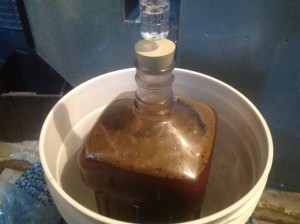 Ok, I admit I’ve left a few things out for simplicity’s sake. I wanted to make this blog a basic overview of the brewing process. Experienced homebrewers are free to point out what I didn’t include, however I will cover things like making yeast starters, cleaning and sanitizing equipment, measuring alcohol content and building grain bills as time goes on. So until next time, happy brewing, and God Bless.
Ok, I admit I’ve left a few things out for simplicity’s sake. I wanted to make this blog a basic overview of the brewing process. Experienced homebrewers are free to point out what I didn’t include, however I will cover things like making yeast starters, cleaning and sanitizing equipment, measuring alcohol content and building grain bills as time goes on. So until next time, happy brewing, and God Bless.





